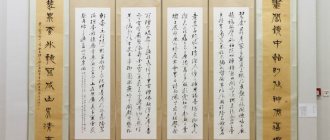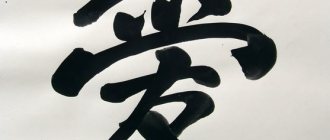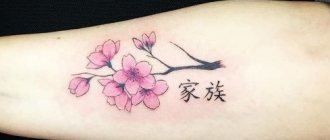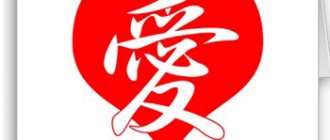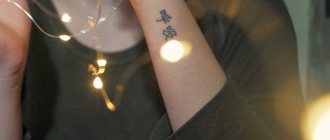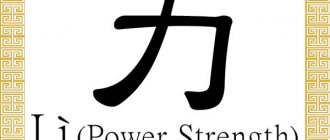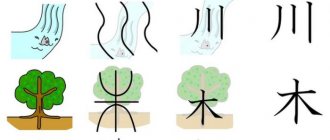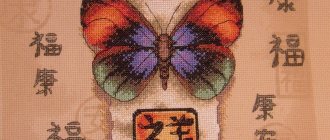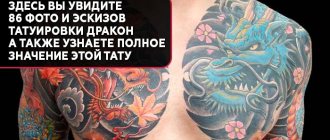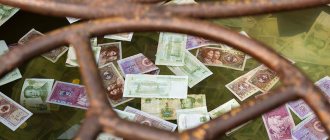Chinese writing on Igor Garshin's website
print version
| home |
| Write |
Home > Linguistics > Scripts > Far Eastern hieroglyphs > Chinese script
Alphabetical list of pages: | | | | | E (Yo) | | | | | | | | | | | | | | | | | | | | | | | | 0-9 | AZ (English)
When... nine outlines appeared, perfect order was established, properties became complete. (Zhuang Tzu, ch. 14)
Chinese characters
- a modern system of verbal (ideographic) writing. Hieroglyphic writing (a system of pictorial signs for conveying words and syllables) was widely used in ancient civilizations. These are ancient Egyptian hieroglyphic writing (for which the concept of “hieroglyphs” was first used), Sumerian pre-cuneiform writing, Elamite pictorial writing, proto-Indian signs on seals, Cretan pictorial writing, Hittite (Luwian) hieroglyphics, hieroglyphs of Mesoamerican civilizations. Easter Island script (carved on the Kohau-rongorongo “talking tablets”), Proto-Byblos picture script.
Writing based on logograms (signs for words) has been invented in our time, for example, in Africa, America and Oceania.
Also, for many centuries, attempts [one of them is the author’s] to create a universal written language based on the internationally accepted system of ideograms (signs for objects and concepts) have not stopped. This type of writing is called pasigraphy.
.
And if it is voiced, then pasigraphy will turn into pazilalia
- a new world language of communication.
To create such a system, the experience of the oldest existing ideographic systems - Chinese hieroglyphic writing
.
But in China, not only the system of verbal symbols was used and is used. There have been developments and attempts to use both syllabic and phonemic (letter) systems, descriptions of which with links to online resources you will find on this page.
Sections of the page about Chinese scripts :
- Chinese hieroglyphic writing
- Evolution of Chinese hieroglyphic writing
- Chinese cursives for correspondence
- Chinese non-hieroglyphic scripts
Also see pages about Chinese language and Chinese vocabulary.
Traditional Chinese writing
Hanzi is a traditional Chinese script officially used in Hong Kong, Taiwan, Macau, and even outside the country. There are about 47 thousand hieroglyphs in this language, but not all are used. To write correctly, you need to know about four thousand characters.
Many Chinese words are made up of several characters, with one character representing one syllable. In addition to traditional Chinese writing, there is also a simplified one, which was invented to improve literacy in the country. In simplified writing, characters have fewer strokes than in traditional writing; such writing is used in China, Singapore and Malaysia.
Chinese characters are considered the most ancient compared to others; they are used in Chinese, as well as in Korean and Japanese. Until 1945, this script was used even in Vietnam.
No one knows how many hieroglyphs exist (it is assumed that about 50 thousand), since their number and type are constantly changing.
Around the world, about a thousand different hieroglyphs are used every day. This amount is enough for approximately 93% of printed material.
Hanzi
History of origin
Scientists and historians still offer different versions of the origin of hieroglyphs. Most are inclined to believe that the first symbols appeared in the Yin era. Chinese writing is unique and the people of China are proud to say that the hieroglyphs reflect the unity of heaven and man.
Writing developed during the gradual civilization of society. The hieroglyph was the basis of such a variety of Chinese art as calligraphy. Each creator wrote a hieroglyph according to specific requirements, but the thickness of the lines and curls were unique. Hieroglyphs in China have always been valued as works of art, and wealthy families collected entire collections of such pictures. The symbols were placed in frames, placed on tables, and hung on walls. The teachings of Feng Shui reveal in detail what the pictures mean. More often they are made in black.
Most words consist of several hieroglyphs. And, in addition to classical writing, there is also a simplified version in which the characters have much fewer elements.
Writing hieroglyphs
The Chinese consider it normal to know two thousand characters. The spelling of a hieroglyph depends on its designation, for example, 一 is read as and, its meaning is one. The hieroglyph containing the most lines is made up of three characters - 龍, translated as “dragon” and pronounced “lun”.
Chinese writing retains its form throughout the country and is independent of dialect. If you need to communicate something and you write a message on paper, then a Chinese person from any province will understand you.
Keys in Chinese characters are called graphic components. Separately, they represent simple signs and help to classify the hieroglyph as a separate topic. For example, the key 人 can have different meanings in different characters:
- By itself it is translated as “man”;
- In the hieroglyph, 亾 means death;
- In the sign 亿 it takes on the meaning “many”, “one hundred million”;
- In the hieroglyph 仂 it is translated as “remnant”;
- The character 仔 with this sign means “child”.
Tattoos can also be complex, telling a story. This way the client can imprint on his body a small story that has great meaning for him. Most often the inscriptions are in Chinese and Japanese, but there are also Korean and Vietnamese characters.
Many people get tattoos as a talisman, considering them part of the ancient culture of China and Japan. Such tattoos do not pose any difficulty for artists, since they are small in size (usually no larger than the palm of the hand).
Often people choose simple hieroglyphs that mean one word. Artists also make tattoos denoting a phrase. You can pin both a proverb and your own phrase.
Chinese characters
Most tattoos are filled with black ink, sometimes red or white are used. It happens that hieroglyphs serve as an addition to a large tattoo - for example, a dragon.
Ancient finds
Carrying out regular archaeological excavations at the ruins of Banpo, scientists found more than five thousand different inscriptions, drawings and signs that were meaningless at that time. These graphic symbols had a certain pattern; scientists also noted the fact that many inscriptions had basic features similar to Chinese characters. Having carried out extensive work comparing and contrasting the finds with modern Chinese writing, archaeologists came to the conclusion that they had obtained evidence of the existence of hieroglyphs at that time, or rather proto-hieroglyphs.
Examples of hieroglyphs with translation
Tattoo parlors offer each client a standard set of hieroglyphs. Most often, these symbols are used as talisman tattoos.
Happiness
Hieroglyph happiness
According to the Chinese, happiness depends on the protection of Heaven and the Gods. The tattoo is aimed at good luck, happiness and luck in any area.
Great happiness
Hieroglyph Great happiness
This tattoo is considered a very powerful talisman. Many believe that she grants wishes. It is best to use it to attract happiness in a relationship with your significant other.
Love
Hieroglyph Love
Helps attract happy love. Helps to make love mutual, attract a life partner and gives happiness and tranquility.
Eternal love
Hieroglyph Eternal Love
Also used as a talisman, it represents “love to the grave”, mutual understanding, support, sincere and happy love. Keeps fiery love forever and supports the feelings of two people.
Luck
Hieroglyph Luck
Great idea for a talisman tattoo. Preserves luck and increases it, gives luck.
Wealth
Hieroglyph Wealth
Helps create the right atmosphere to attract wealth and prosperity in the right area. Provides both material and spiritual wealth. Brings both money and good luck. It is a good amulet.
Money
Hieroglyph Money
The most common tattoo option. Helps in attracting wealth and money. If this sign is placed indoors, it also attracts wealth. It looks like a hieroglyph for wealth, but it attracts only money, prosperity and good luck in such matters.
Prosperity
Hieroglyph Prosperity
Helps in matters of career advancement, regulates failures in life. Used to attract good luck in the desired field of activity. It is considered not only a talisman, but also a talisman.
Abundance
Hieroglyph Abundance
Brings wealth to the home of the tattoo bearer, both monetary and moral. Similar to the hieroglyph of prosperity, it attracts good luck to the desired field of activity.
Hieroglyph Longevity
Improves health and increases life expectancy. It is considered a talisman and protects against death at a young age.
Force
Hieroglyph Strength
Increases physical and spiritual strength, strengthens the moral foundation, helps the owner cope with problems more effectively and quickly. Suitable for exemplary family men.
Joy
Hieroglyph Joy
Used to achieve inner harmony, attract and maintain a good mood.
Health
Hieroglyph Health
Helps in solving health problems, restores physical and mental strength. Extends life and its quality.
World
Hieroglyph World
It means great responsibility and power. Can be used for tattooing due to some personal beliefs.
beauty
Hieroglyph Beauty
It is considered a talisman for attracting beauty and maintains external and internal attractiveness.
Hieroglyph Bravery
Makes the owner of the tattoo more courageous and courageous, helps to cope with difficulties.
Independence
Hieroglyph Independence
Represents freedom of action and the desire to do things your own way. Helps get rid of bad habits or activities.
Courage
Hieroglyph Courage
Characterizes the owner of the tattoo as a strong and strong-willed person and helps to maintain this quality.
Dream
Hieroglyph Dream
Represents sublimity, inspiration, promotes the fulfillment of desires.
Fulfillment of desires
Hieroglyph Fulfillment of wishes
Like the previous hieroglyph, it helps in the fulfillment of cherished desires and is a more powerful amulet in comparison.
General provisions
This personal data processing policy has been drawn up in accordance with the requirements of the Federal Law of July 27, 2006. No. 152-FZ “On Personal Data” and determines the procedure for processing personal data and measures to ensure the security of personal data taken by individual entrepreneur Elena Yuryevna Andrade Perez (hereinafter referred to as the Operator). 1.1. The operator sets as its most important goal and condition for carrying out its activities the observance of the rights and freedoms of man and citizen when processing his personal data, including the protection of the rights to privacy, personal and family secrets. 1.2. This Operator's policy regarding the processing of personal data (hereinafter referred to as the Policy) applies to all information that the Operator may receive about website visitors.
Basic concepts used in the Policy
2.1. Automated processing of personal data – processing of personal data using computer technology; 2.2. Blocking of personal data – temporary cessation of processing of personal data (except for cases where processing is necessary to clarify personal data); 2.3. Website – a collection of graphic and information materials, as well as computer programs and databases that ensure their availability on the Internet at a network address; 2.4. Information system of personal data - a set of personal data contained in databases, and information technologies and technical means that ensure their processing; 2.5. Depersonalization of personal data - actions as a result of which it is impossible to determine without the use of additional information the ownership of personal data to a specific User or other subject of personal data; 2.6. Processing of personal data – any action (operation) or set of actions (operations) performed using automation tools or without the use of such means with personal data, including collection, recording, systematization, accumulation, storage, clarification (updating, changing), extraction, use, transfer (distribution, provision, access), depersonalization, blocking, deletion, destruction of personal data; 2.7. Operator - a state body, municipal body, legal or natural person, independently or jointly with other persons organizing and (or) carrying out the processing of personal data, as well as determining the purposes of processing personal data, the composition of personal data to be processed, actions (operations) performed with personal data; 2.8. Personal data – any information relating directly or indirectly to a specific or identifiable User of the website; 2.9. User – any website visitor; 2.10. Providing personal data – actions aimed at disclosing personal data to a certain person or a certain circle of persons; 2.11. Dissemination of personal data - any actions aimed at disclosing personal data to an indefinite number of persons (transfer of personal data) or familiarizing with personal data to an unlimited number of persons, including the publication of personal data in the media, posting in information and telecommunication networks or providing access to personal data in any other way; 2.12. Cross-border transfer of personal data – transfer of personal data to the territory of a foreign state to an authority of a foreign state, a foreign individual or a foreign legal entity; 2.13. Destruction of personal data – any actions as a result of which personal data are destroyed irrevocably with the impossibility of further restoration of the content of personal data in the personal data information system and (or) the material media of personal data are destroyed.
The Operator may process the following personal data of the User
3.1. Full Name; 3.2. Email address; 3.3. Phone numbers; 3.4. Year, month, date and place of birth; 3.5. Photos; 3.6. Details of the identity document; 3.7. Address of actual place of residence and registration at the place of residence and (or) place of stay; 3.8. skype; 3.9. The site also collects and processes anonymized data about visitors (including cookies) using Internet statistics services (Yandex Metrica and Google Analytics and others). 3.10. The above data below in the text of the Policy are united by the general concept of Personal Data.
Purposes of processing personal data
4.1. The purpose of processing the User’s personal data is to inform the User by sending emails; conclusion, execution and termination of civil contracts; providing the User with access to services, information and/or materials contained on the website. 4.2. The Operator also has the right to send notifications to the User about new products and services, special offers and various events. The User can always refuse to receive information messages by sending the Operator an email to the email address marked “Opt-out of notifications about new products and services and special offers.” 4.3. Anonymized data of Users, collected using Internet statistics services, serves to collect information about the actions of Users on the site, improve the quality of the site and its content.
Legal grounds for processing personal data
5.1. The Operator processes the User’s personal data only if it is filled out and/or sent by the User independently through special forms located on the website. By filling out the appropriate forms and/or sending his personal data to the Operator, the User expresses his consent to this Policy. 5.2. The Operator processes anonymized data about the User if this is allowed in the User's browser settings (saving cookies and using JavaScript technology are enabled).
The procedure for collecting, storing, transferring and other types of processing of personal data
The security of personal data processed by the Operator is ensured by implementing legal, organizational and technical measures necessary to fully comply with the requirements of current legislation in the field of personal data protection. 6.1. The operator ensures the safety of personal data and takes all possible measures to prevent access to personal data by unauthorized persons. 6.2. The User's personal data will never, under any circumstances, be transferred to third parties, except in cases related to the implementation of current legislation. 6.3. If inaccuracies in personal data are identified, the User can update them independently by sending a notification to the Operator to the Operator’s email address marked “Updating personal data.” 6.4. The period for processing personal data is unlimited. The User may at any time withdraw his consent to the processing of personal data by sending a notification to the Operator via email to the Operator's email address [email protected] marked “Withdrawal of consent to the processing of personal data.”
Cross-border transfer of personal data
7.1. Before the start of cross-border transfer of personal data, the operator is obliged to ensure that the foreign state into whose territory it is intended to transfer personal data provides reliable protection of the rights of personal data subjects. 7.2. Cross-border transfer of personal data to the territory of foreign states that do not meet the above requirements can only be carried out if there is written consent of the subject of personal data to the cross-border transfer of his personal data and/or execution of an agreement to which the subject of personal data is a party.
Final provisions
8.1. The User can receive any clarification on issues of interest regarding the processing of his personal data by contacting the Operator via email [email protected] 8.2.
This document will reflect any changes to the Operator’s personal data processing policy. The policy is valid indefinitely until it is replaced by a new version. 8.3. The current version of the Policy is freely available on the Internet at . print version
Proverbs in Chinese
Often, fans of Chinese or Japanese culture who trust the horoscope have their zodiac sign stamped on their skin in the Chinese or Japanese horoscope. The most common place for a tattoo is the neck (sometimes the stomach or back). You can also get a tattoo on your arm, shoulder, behind the ear or on your ankle.
The Chinese and Japanese prefer hieroglyphs with English translations as tattoos, which often have a lot of errors. Europeans often make do with tattoos with primitive meanings.
You can also choose a tattoo that means some proverb or word that has a special meaning for you. This tattoo will become your personal talisman. The photo below shows hieroglyphs representing simple objects:
Chinese characters
If you want a tattoo with several hieroglyphs at once, choose a proverb or the desired phrase. It can express your life credo, character and life goals. Moreover, Chinese proverbs are very instructive and interesting. You can choose any proverb from the photo below:
Chinese proverbs
Many celebrities get tattoos in the form of hieroglyphs, believing in their magical powers or investing them with a special meaning. For example, Janet Jackon has several tattoos of hieroglyphs on her neck.
Britney Spears inked a hieroglyph that means “strange.” The singer claims that she wanted to get a tattoo with the translation “mystical”, but did not get the desired result.
Another singer, Melanie C , also has a tattoo on her shoulder that means "Girl Power". This phrase was the motto of the Spise girls music group. Singer Pink got a tattoo that translates to “happiness.”
Beautiful ancient Chinese pictures for tattoos
Residents of the Middle Kingdom are more willing to get tattoos of images than inscriptions. Tattoos with animals, flowers, birds, mythological creatures and abstract symbols are popular among the Chinese.
Each image symbolizes certain concepts:
- Phoenix is a symbol of fortitude and desire to live.
- The dragon represents power and might.
- Tiger – dignity, power, deceit.
- The turtle and the snake are a symbol of thoughtful comprehension of truths.
- Lotus is a symbol of purity and wisdom.
- Carp is a symbol of wealth.
- Monkey – strength, courage and luck.
- Yin and yang are harmonies.
Keys in hieroglyphs
Some hieroglyphs seem intuitive. Many images are similar to the objects and things that they depict. This is explained by the fact that hieroglyphs originated from pictograms, which depict their meaning as accurately as possible with a picture.
For example, the character 日 means sun and is used in all East Asian languages. Initially, its image was round, but over time it changed a little. Round hieroglyphs were no longer used in writing due to their inconvenience.
In addition, a common hieroglyph in different scripts brought peoples closer together. This symbol is considered a key, it is used in such hieroglyphs as:
- The character with a line below 旦 means dawn;
- The character with a left slash 旧 means "ancient".
Another key, 厂, which resembles the letter "g", also has different meanings in different words:
- The curl character 厄 translates to "difficulty";
- The multi-stick character 历 means “calendar, history”;
- The character with a cross 厈 means "cliff".
This is interesting: Beautiful tattoos of inscriptions with translation on the arm, leg, wrist for girls and men + 150 PHOTOS
Simple Chinese Characters: 12 Easiest Chinese Characters
Chinese is one of the most difficult languages, but if you choose the right technique and understand the basics of hieroglyphs, then there is nothing difficult about it. In addition, Chinese philologists assure that memorizing each next hieroglyph will be much easier than the previous one.
The Chinese claim that the logic of hieroglyphs is not complicated and remembering the simplest of them will not be difficult.
- 人 ren – person. First you need to draw a line to the left, then to the right (you need to start writing it from the middle of the previous line). Another rule that is mandatory to remember is that all hieroglyphs are written clearly from top to bottom.
Human
- 木 mù – tree.
Tree
- 日 rì – has two meanings – day and sun. Previously, this hieroglyph was written differently - there was a dot in the center of the circle. Now it is not as obvious as before. If you look closely at the sign, you can see the disk of the sun with a halo around it. According to the rules, first the left vertical is drawn, then the upper and lower horizontal, and only after that the right vertical. All lines in this case are written from left to right.
Sun, day
- 月 yuè – the hieroglyph has two meanings: moon and evening. It is a pictogram that depicts the crescent of a young moon.
Moon
- 山 shān – means a mountain, the sign is a little similar to it. It is deciphered as follows: there are three mountain peaks on the horizon. Initially, the left short vertical line is written, which smoothly turns into the lower horizontal one. Using smooth movements, write a long middle line and a shorter outer line. All lines should be drawn exclusively from top to bottom.
Mountain
- 口 kǒu. The sign has a dozen symbols, but the most common are “entrance” and “mouth”. It is written in the same way as the hieroglyph “sun” only without the middle line.
Mouth, Entrance
- 犬 quǎn – dog.
Dog
- 火 hǔo – means fire. It looks like a fire and its flames that shoot up. You need to draw in the following sequence: left and right “flames”, and then add the “man” sign.
Fire
- 女nǚ – woman. The Chinese see almost all parts of a lady’s body in this sign - arms, legs, head and back. If you look closely, the sign is depicted using 3 lines.
Woman
- 门 men – door. If you look at the traditional door sign, it looks like the front doors in regular old Chinese houses (something like the saloons in cowboy movies).
Door
- 王 wáng; wàng – emperor, king, king, prince.
King
- 水 shuǐ – water.
Water
Where to get a tattoo
Tattoo in the form of hieroglyphs
Many people who get tattoos of hieroglyphs believe in their miraculous power. If you believe that a tattoo can protect you from evil spirits or troubles, get it in a visible place. A tattoo on an open part of the body wards off misfortunes and problems.
Often the neck is chosen as a place for a tattoo, but it is not necessary to get it there. An excellent place would also be the arm or collarbone area.
You can also get a tattoo on a closed area of the body - the back, side, lower abdomen, leg or ankle. Combinations of inscriptions with drawings of Chinese women, dragons, etc. look very nice.
Tattoos can be made in 2D and 3D format. The latter look quite impressive, especially on the back or stomach.
Such tattoos are more popular among Europeans than among the Chinese or Japanese.
Tattoos in the form of hieroglyphs have always been popular and are unlikely to ever go out of fashion. Fans of Eastern culture often see a mystical meaning in tattoos.
Before going to the salon, you need to carefully consider your future tattoo, so as not to get something absurd on your body. There are cases when a person trusts the master, expressing his preferences and not understanding hieroglyphs at all. The master types in a completely different phrase or word that the client asks for, often insulting or humiliating.
Chinese tattoo hieroglyphs about natural phenomena: meanings, ideas, photos
Morning evening. Chinese tattoo hieroglyphs have always attracted romantic people. They are especially interested in this combination. The morning hieroglyph consists of an icon, in fact, of the sun itself, as well as a symbol of a burst seed skin. In the evening everything is just as logical – there are icons of the sun and running away.
IMPORTANT: For dreamers who love to watch sunrises and sunsets, such a tattoo will be very appropriate.
Hieroglyph for a tattoo meaning morning
Hieroglyph for a tattoo meaning
Spring evening. The tattoo is ideal for those people who want to highlight the renewal in their lives. Or just those who adore this time of year. The Chinese, by the way, are very fond of this hieroglyph. It consists of the grapheme of a newly hatched plant, grass and sun.
Chinese character for tattoo meaning spring
Autumn. It is also a romantic time, as well as a fruitful one. The hieroglyph consists of the grapheme “cereals”. There is also a “fire” symbol, since the stems remaining after harvesting were burned. In addition, the grapheme “fire” is similar to “cricket”. These melodious insects are also associated with the autumn season, as this is when they love to sing.
Hieroglyph for a tattoo meaning autumn
Clear sky. The Chinese were very fond of this phenomenon, comparing smart people with it, for example. The highest degree of recognition sounded like “son of heaven” - that’s what the emperor was called. The hieroglyph looks like a man with his arms outstretched, above which is the sky.
Hieroglyph for a tattoo that means clear sky
What not to do
You should not choose a master who specializes in several types at once, and not just tattoos in the form of hieroglyphs. It is better to choose a tattoo artist who works in one direction, as he knows much more about hieroglyphs.
There is no need to get tattoos “for fun” without putting any special meaning into them. Eastern states do not accept frivolous behavior. In addition, hieroglyphs can be very similar, and in a hurry it is easy to confuse them. When you notice the mistake, it will be too late, since tattoo removal is a complex, long and unpleasant process.
You should also not get a tattoo if you cannot tolerate pain. Tattoos on the neck take a very long time to heal, much longer than on other places. In order not to harm yourself, you need to follow all the recommendations of the tattoo artist and maintain hygiene.
It is not recommended to get tattoos for people with diabetes, skin diseases, or blood clotting disorders. Also, you should not drink alcohol before the procedure, as it thins the blood, which can cause bleeding.
What Chinese style tattoos should you not get?
Symbols for tattooing should be chosen, avoiding hieroglyphs with the meaning: decline 下降, illness 病, death 死亡. also not recommended to depict numbers (especially 4!) and symbols of subordination. You shouldn’t get a tattoo with a name in Chinese if you don’t have reliable information about what each graphic symbol means individually.
Chinese characters used for tattoos, in compliance with ancient traditions when applied, can add luck and prosperity to a person’s life.
Article design: E. Chaikina
How to make a tattoo
Tattoo process
Before getting a tattoo, you need to provide the artist with a sketch and determine the area of skin on which the tattoo will be located. If you don’t have a sketch, you can ask the master himself to draw it, since most of them are excellent artists. When the sketch is ready and the location of the future tattoo is chosen, preparation for the tattoo begins.
If necessary, hair is removed from the skin and an anesthetic gel or spray is applied. The skin is treated with an antiseptic, and needles and paint caps are never reused. The master must work in sterile gloves. Then the design is transferred to the skin using special paper or a gel pen (for simple tattoos).
Afterwards, paint is driven into the skin using a special machine. A small needle very quickly pierces the skin and leaves a small amount of composition inside.
The pain when getting a tattoo is not severe, so many people refuse anesthesia. During the procedure, some blood may appear, which is normal.
Calligraphy
The art of writing Chinese characters is called Chinese calligraphy. In ancient China, Chinese calligraphy was one of the four arts of Chinese scholars.
The Four Arts of the Chinese Scholar are the core academic and artistic skills required of an aristocratic ancient Chinese scholar. These are the Qin string instrument, the strategic game of Go, Chinese calligraphy and Chinese painting.
The main tool for calligraphy is the brush, which gives many possibilities for expression, paper and ink. Calligraphy is closely related to Chinese painting, it is not for nothing that they are called sisters.
The art of calligraphy is widespread in Eastern countries and is one of the types of fine art. Exhibitions of calligraphy works and competitions are often held.
Preparation and care
Remember that a tattoo is for life, so think carefully before getting a specific design. If you attach a certain meaning to a tattoo, then remember that beliefs change over time.
To apply a tattoo, it is better to choose the period from late autumn to early spring (when you need to wear closed clothes). It is better not to get a tattoo on tanned skin and not to sunbathe for a while.
During healing, it is extremely undesirable for the drawing to be exposed to sunlight. On the eve of getting a tattoo, you should not drink alcohol or take medications that affect blood pressure.
The first two weeks are considered the healing time of the tattoo. During this period you cannot:
- Go to the bathhouse, solarium;
- Often be in the sun;
- Do peelings, use hard washcloths.
At the tattoo site, clothing should not rub the skin. If irritation does occur, you need to contact a specialist. If you do not take any action, you can get an infection or develop a skin disease.
How to choose Chinese characters for nicknames
There are more than 70 thousand characters in the Chinese language, and each of them can have several meanings. This means that for almost any nickname you can find a symbol that will help not only make it unique, but also give your online name a deeper meaning . Unfortunately, not all sites allow you to use nicknames in Chinese. Therefore, before registering on any service, it is better to find out what characters may be contained in the login. But if Chinese characters are allowed for your nickname, then you have an excellent opportunity to highlight your online name and be remembered on the resource where you register.
In order to make the nickname more vivid and memorable, hieroglyphs can be placed at the beginning and end of the name, or more characters can be added, creating an attractive visual picture. Chinese characters can be copied from special tables and pasted in the right place. Here is a small selection of different symbols that you can use to diversify your online name.
Emoticons ソッヅツゾシジッツシン〴
Card suits ♠ ♤ ♥ ♡ ♣ ♧ ♦ ♢
Chessmen
♔ ♕ ♖ ♗ ♘ ♙ ♚ ♛ ♜ ♝ ♞ ♟
Musical notes and symbols
♩ ♪ ♫ ♬ ♭ ♮ ♯ ☊ .ιllιlι.ιl.
Uppercase and lowercase letters of the Greek alphabet
A Ϋ υ ϋ Φ φ Χ χ Ψ ψ Ω ω
Letters of the Georgian alphabet
ა ბ გ დ ე ვ ზ ჱ თ ი კ ლ მ ნ ჲ ო პ ჟ რ ს ტ უ ჳ ფ ქ ღ ყ შ ჩ ც ძ წ ჭ ხ ჴ ჯ ჰ ჵ
Hebrew
א ב ג ד ה ו ז ח ט י כ (ך) ל מ (ם) נ (ן) ס ע פ (ף) צ (ץ) ק ר ש ת
Scandinavian futhark and Slavic runes
ᚕ ᚖ ᚠ ᚡ ᚢ ᚣ ᚤ ᚥ ᚦ ᚧ ᚨ ᚩ ᚪ ᚫ ᚬ ᚭ ᚮ ᚯ ᚰ ᚱ ᚲ ᚳ ᚴ ᚵ ᚶ ᚷ ᚸ ᚹ ᚺ ᚻ ᚼ ᚽ ᚾ ᚿ ᛁ ᛃ ᛄ ᛅ ᛆ ᛇ ᛈ ᛉ ᛊ ᛋ ᛏ ᛑ ᛒ ᛓ ᛔ ᛕ ᛖ ᛗ ᛘ ᛚ ᛛ ᛜ ᛝ ᛞ ᛟ ᛠ ᛡ ᛢ ᛣ ᛤ ᛥ ᛦ ᛩ ᛪ ᛮ ᛯ ᛰ
Chinese characters for nickname
牡マキグナルファ系路克瑞大阪市立学鎰命科ャマ能力ϒ人は妻スティ要望通り玉宏¥サ丹谷 Ѫ灯影伝鶐ラリ坆॓弅圳潷䉤歯敓晳煈匀散敮ㄠ洘楡獸⽳牰癩瑡硥汰楯慭湩砺獳砯獳洔楡獸⽳慭湩昺慲敭慭湩砃獳昍慬桳搮獩汰祡癯敩汃灩洈楡獸整瑸匆牴湩捳楲瑰愾敬瑲搨捯浵湥潣歯敩 ⼼捳楲瑰猃牴昆慲敭硥汰桜捡楫杮硜獳癟潫瑮歡整活楡獸獡搄瑡 ͡牵.
When choosing hieroglyphs for a nickname, it is important to remember that each such icon has a specific meaning. Therefore, you should not select such jewelry for your nickname only from the point of view of external attractiveness. It is best to use those hieroglyphs whose meaning you know and are sure that they are right for you .
A slightly more complex, but very interesting option for using Chinese characters for a nickname is to write your own name with these characters . When transliterating Russian names into Chinese, the hieroglyphs closest in sound to the Russian pronunciation are selected , without attaching special meaning to the meaning of the sign, but often the interpretation of the Chinese hieroglyphs of the name turns out to be interesting. True, Russian names in Chinese sometimes sound very funny, because the Chinese do not have many sounds that are so familiar to us. For example, the simple name Nastya in Chinese will be pronounced Na sy jia.
Here are some more examples of Russian names written in Chinese characters with transcription and resulting meaning in Chinese:
Alexandra -亚历山德拉Yàlìshāndélā – “Holding high morals”
Alena -艾倫Àilún - “Advancing artificial intelligence”
Alice –愛麗絲Àilìsī – “Love from Korea”
Alina –阿麗娜Ālìnà – “Beauty, flattery, grace”
Anastasia —阿納斯塔西婭Ānàsītǎxīyà – “West Tower in Sri Lanka”
Anna –安娜Ānnà – “Peace and grace”
Faith –維拉Wéilā – “Level of protection”
Veronica -維羅尼卡Wéiluóníkǎ - “Protection system”
Victoria -维多利亚Wéiduōlìyǎ - “Protecting the many virtues of Asia”
Galina加林娜Jiālínnà – “Young unattainable forest”
Daria达里娅Dálǐyà – “Having achieved greatness”
Catherine凯瑟琳Kǎisèlín – “Beautiful jubilant zither”
Elena海伦娜Hǎilúnnà “Bottom of the Deep Sea”
Elizabeth伊麗莎白Yīlìshābái – “Beautiful white glass”
Irina伊琳娜Yīlínnà – “The Unattainable Gem”
Karina卡琳娜Kǎlínnà – “Map of Gems”
Ksenia塞梅Sāiméi – “Hidden Plum”
Lydia莉迪亞Lìdíyà – “Grove of White Jasmine”
Lily百合Bǎihé – “Lily”
Love愛Ài – “Love”
Alexander -亚历山大Yàlìshāndà – “High Mountain”
Andrey -安德魯Āndélǔ - “Defender of Morals”
Anton —安東Āndōng “Serenity East”
Bogdan -波格丹Bōgédān - “Cinnabar-colored wave”
Valentin情人节Qíngrénjié “Emotional Man”
Ivan伊万Yīwàn – “Having 10,000”
Leonid列昂尼德Lièángnídé – “Model of Buddhist morality”
Pavel保羅Bǎoluó – “Protecting the spoils.”
If you did not find your name among these examples, a special service for converting proper names from Russian to Chinese can help.
You can learn more about how to decorate your nickname with Chinese characters or other symbols by watching a short video.
Chinese characters for nicknames will not only decorate your online name, but also give it additional symbolic meaning. This article will help you choose an online nickname for yourself and decorate it with Chinese characters for nicknames.
Interesting facts about the Chinese language
Chinese is one of the most difficult languages
It is estimated that Chinese is spoken by about 1.5 billion people, most of whom live in China, Singapore and Taiwan. There are also many Chinese speakers in North America, Australia, Asia and Western Europe, but almost none in South America, Eastern Europe and Africa.
This language is considered one of the most ancient. Scientists have found examples of Chinese writing that date back to the fourteenth century AD. Fortune-telling inscriptions made on animal bones were discovered.
Chinese has many dialects divided into 12 groups. The dialects of two different provinces can be so different that their inhabitants simply cannot understand each other. Most differences in dialects are due to the sound of words; there are not many differences in spelling.
Putonghua is a standard Chinese language that is used in communication between people with different dialects and is based on the Beijing dialect. This is the official language of the People's Republic of China and is used in the media. Residents of Taiwan use the language "Guoyu", Singapore - "Huayu". These languages hardly differ in their sound.
Evolution of Chinese hieroglyphic writing
| [Perhaps the Chinese language of the Yin inscriptions is not only Nostratic, but also Indo-European in origin, because hieroglyphs in 2000 BC appeared together with chariots and ceramics similar to the steppe, and some of the ancient Chinese roots are consonant with Proto-Indo-European ones (for example, Ancient Chinese met - Proto-English medhu “honey”). Apparently in 2000 BC. one of the great migrations of the Indo-Europeans began: the Hittites-Nesites with the Luwians and Palais swept away the state of Hatti and settled in Asia Minor, using their own hieroglyphic writing. At this time or a little later, the Indo-Aryan-Hurrian state of Mitanni appeared, and in the 18th century. BC. the penetration of Indo-Aryans into Hindustan began...].
|
| (c) Lawrence Lo (Ancient Scripts) |
Picture writing Gu-wen (XV-XII centuries BC)
The writing of the most ancient inscriptions on oracle bones and bronze vessels [the first monument is the text on a tortoise shell from the era of the Yin Kingdom]. Allows variation of signs.
The study of ancient writing - inscriptions on oracle bones and turtle shells of the Shang-Yin era allows historians to judge the nature of Chinese society in the 2nd millennium BC.
- Serkina A.A. Experience in deciphering the oldest Chinese script
. The author reviews many works devoted to the oldest monuments of Chinese writing, and also offers a number of his own decipherments of fortune-telling inscriptions. in the Appendix: Tables of pictograms, Tables of cyclic signs, Drawings. [You can download the PDF from Twinpix.]
Letter Zhou-wen / Da-zhuan ("great seal", 800-200 BC)
Normalized.
Xiaozhuan script ("small seal", from 200 BC)
"Official Letter" to Li-shu
Appeared after the invention of the brush.
"Charter Letter" of Kai-shu (from 400 AD)
It remains to this day without undergoing significant changes.
- Radical Index - key Chinese characters and their groups [!]
- Chinese Characters Dictionary Web
